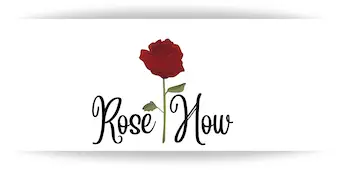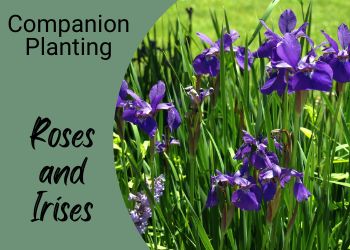Roses and irises can create some stunning color combinations, not only in the garden but in bouquets too.
Here I’m going through the growing differences and similarities when planting irises and roses together. So you can decide if this is a good combination for your rose bed. Here’s a quick summary.
Roses and irises are ideal companion plants. They share the same soil and sun needs and irises won’t overshadow or overgrow your roses. They both come in an array of colors and bloom around the same time. Iris also attracts pollinators. You just need to manage their differing water requirements.
That’s the summary, but let’s break this down a little further in case there are aspects you’re particularly thinking about for your garden.
Planting Roses and Irises Together
Here’s a summary table that also outlines the main points of roses and irises.
| Roses | Irises | |
|---|---|---|
| Growing zones | Ideally 7 – 10 | 3 – 9 |
| Color | Red, Pink, Yellow, White, Orange, Purple, Blue, and other color mixes | Purple, Blue, Red, Peach, Yellow, Orange, Rose, Black, and White |
| Height | Depends on the variety. But generally, 2 – 5 feet | 8 inches to 3 feet tall. A Spread of 2 – 3 feet of space |
| Blooming period | Early spring to mid or late summer | Late spring to early summer. Some bloom again in late summer |
| Soil | Loamy, well-drained soil | Loamy, well-drained soil |
| pH Value | 6.5 to 7.0 | 6.5 to 6.8 |
| Sun | 6+ hours per day | 6+ more hours. Partial shade |
| Water Needs | 1-2 inches, every 3-4 days | Once every 7-8 days |
| Pollination and Pests | Minimal pollinators. Also attracts aphids | Will attract pollinators. Minimal pests |
That’s the table summary, let’s get into some detail for growing iris and roses together.
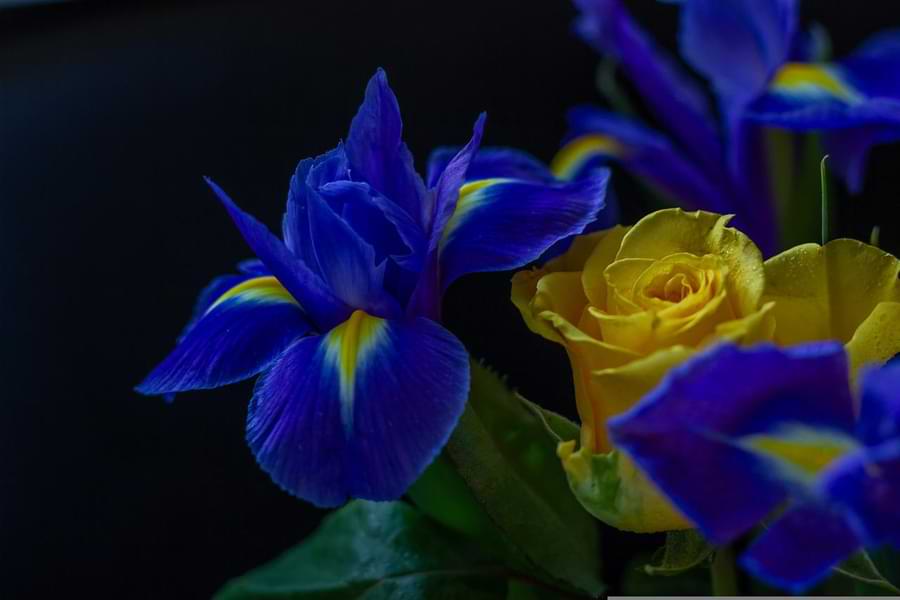
Growing zones for Irises and Roses
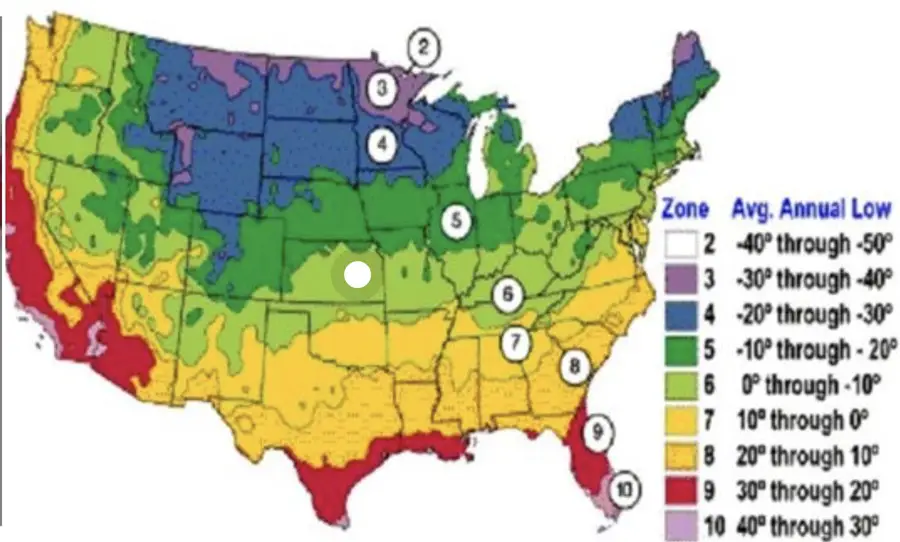
Iris is a genus that consists of 260 to 300 plant species generally thriving in a wide range of hardiness zones of between 3 and 9 as defined by the USDA. So they have multiple species that share the same hardiness zones with roses.
Some examples include:
- Earl of Essex – in most zones 3 – 10
- Jennifer Rebecca – hardy to zones 4 – 9
- Fond Kiss – found in zones 4 – 8
- Feedback – hardy to zones 5 – 9
Roses generally thrive more in hardiness zones 7 – 10, but 5 and 6 are also common, and you can grow roses that thrive in colder climates too.
Color options
Irises are rich in colors and make a flamboyant addition to any garden. Moreover, once they are paired with roses the scents of both companion plants make it a perfume-striking duo guaranteed to please any visitor.
They are mostly found in purple, blue, red, peach, yellow, orange, rose, black and white. But more than that, they can help to contrast your roses, soften the color hues, and provide a romantic or traditional garden color scheme.
But it doesn’t end here, irises have numerous species available in bi-colors. Some examples of colors and bi-colors are indexed below:
- Blueberry fair – ruffled blue flowers
- Coho – pink and golden bicolored flowers
- Earl of Essex – white and purple double tinted petals
- Feedback – scented deep purple flowers
- Fond Kiss – white flowers with a slight pinky touch
- Jennifer Rebecca – fuchsia pink petals
- Variegata – violet and red multi-shade petals.
Comparable heights
In terms of height, irises are the perfect partners for roses. Because they are mostly smaller than the average rose bush. So they won’t overshadow, or intermingle with the rose flowers, creating a perfect array of color on all levels, and providing a great garden balance.
So height-wise, Irises are mostly 8 inches to 3 feet tall and need 2-3 feet of space for proper blooms. So, it doesn’t even reach the roses’ standard height which is more than 4 feet and up to 6 feet.
Blooming period
Your roses will be expected to bloom between early to mid-spring, and through to mid or late summer.
Most iris varieties will flower from late spring into early summer with a few exceptions. A couple being the Siberian Iris, and the bearded hybrids. These may flower again later in the summer.
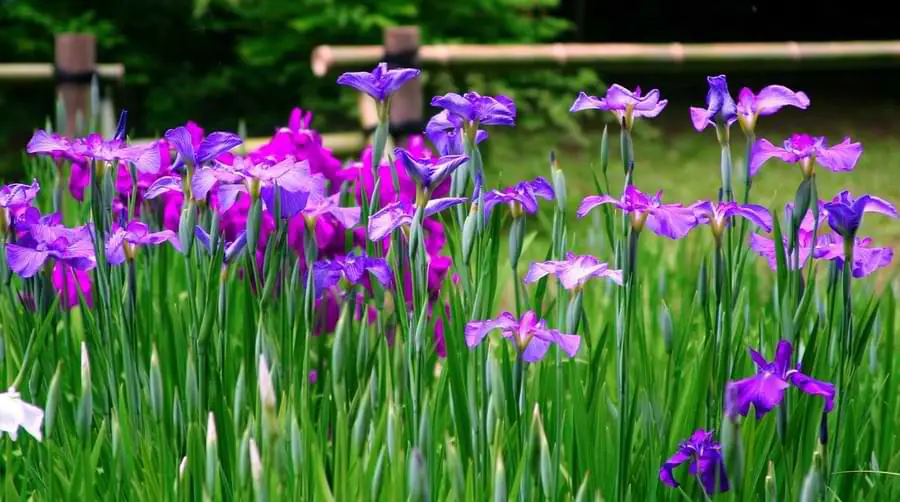
Soil and sun
Irises like well-drained soil, and generally loam soil is an ideal option.
The same goes for roses. But irises also like a slightly raised soil bed – or sloping area to further avoid water logging. And that’s okay, roses don’t like to be waterlogged either.
The pH soil for roses and irises is almost perfectly aligned. Roses prefer a pH of around 6.5 to 7.0. Irises prefer a pH of 6.5 to 6.8. So anywhere within the iris pH range will work well for both plants.
If you need soil treatment, then I looked at all the different types. Here’s my favorite type of compost for roses.
Sun requirements are completely similar for both roses and irises as companion plants. Just like roses, irises mostly like the full and direct sun – for more than 6 hours daily, but can tolerate partial shade for some time.
Prolonged shade for roses would mostly result in reduced growth and fewer blooms.
And because of their differing water requirements, which I’ll come to next, it’s best to keep these plants at least 3 – 4 feet apart.
Water requirement
Although the sun, soil, and hardiness zones are similar in both, roses and irises, water requirements are quite distinctive. So it’s something to keep in mind, but it can be easily managed.
Roses need plenty of water almost daily in hot weather that’s why they like well-drained soil.
But irises need water in general only around every 7 to 8 days, depending on rainfall. And are also referred to as drought-resistant plants. Thus they can survive a fair amount of water deprivation.
Not only this but watering them quite often can actually damage the leaves and flowers. In case of cold weather, irises may not even need water for weeks or months.
So, you need to keep a safe distance of 3 – 4 feet between both of these plants and don’t water your irises every time you water your roses.
Here’s more on when to water roses.
Pests and pollinators
Most people love the scent that roses bring, but Irises and roses are both heavily scented flowers and produce nectar too. So here’s some info on the pollinators, and pests too.
Irises are very famous for repelling deer from the open garden and farms, but of course, most homes don’t face this situation.
For home gardens though, irises are very helpful in attracting bees, butterflies, and various small birds including the hummingbird. Whereas roses can struggle to attract bees.
Irises do not generally attract harmful insects. Any few exceptions can be treated with simple pest repellants.
Next, let’s look at some great Iris options.
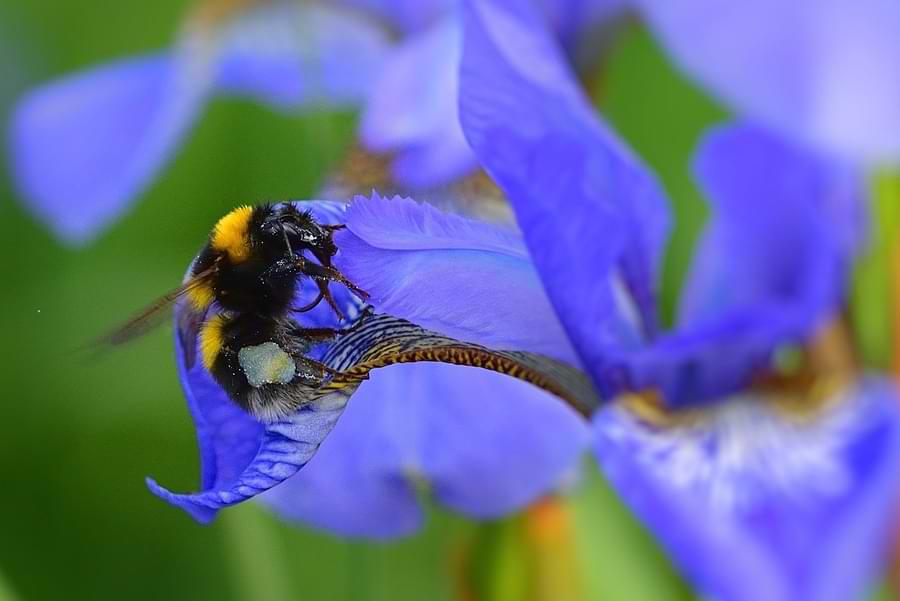
Iris options for roses
If you’re looking for a few iris options you can plant alongside your roses, here are a few to get your juices flowing.
Immortality tall bearded Iris
Iris germanica ‘Immortality’
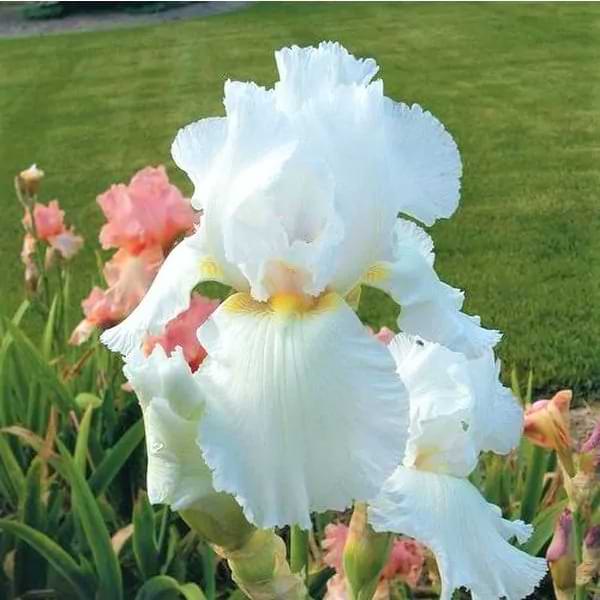
Don’t let the word tall put you off when discussing irises. These mature to around 2 to 3 feet in height. And they provide a striking white color, which would contrast perfectly with dark color roses, or mix in with your white, yellow, and pink roses for a softer look,
It’s also suitable for zones 3 – 9 so almost all rose growers can companion plant these irises.
Check availability of immortality tall bearded iris.
Ruffled Velvet Siberian Iris
Iris siberica ‘Ruffled Velvet’
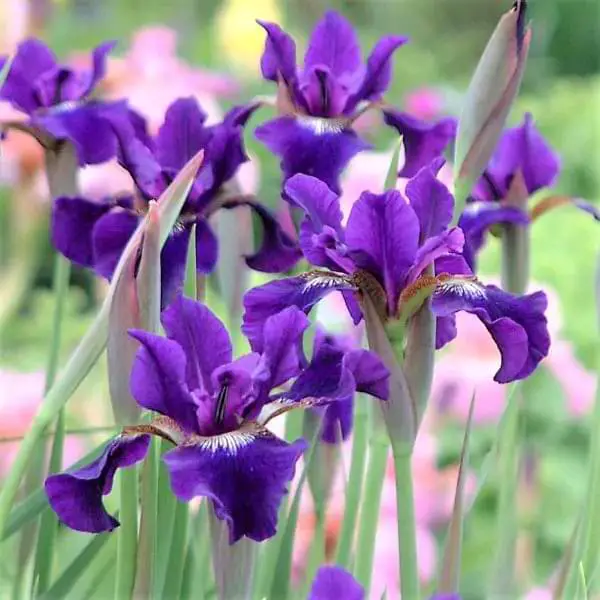
If you’re looking for a velvety flower with some romance to go with your hybrid teas, then the ruffled Siberian iris might be the answer. It grows to a height of 3 feet in zones 4 – 9 and with a wide tolerance of soil types which might help.
Line them along your rose bed border, add to your containers and even use them as cut flowers with your roses too.
Check availability of Ruffled Velvet Siberian Iris
Pink Attraction Bearded Iris
Iris germanica ‘Pink Attraction’
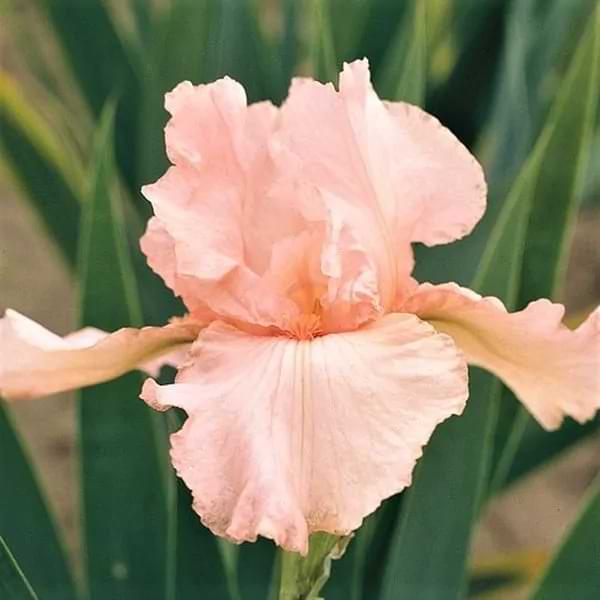
If you’re going for the soft traditional look in your garden, then the pink attraction might be the one. Its romantic and softer tones will enhance the deep rose colors.
It grows in zones 3 – 9 and its grey to green foliage will add some contrast to the deep green rose foliage. This variety also doesn’t mind some partial shade.
Check availability of Pink Attraction Tall Bearded Iris
Roses and Irises ~ More roses help 🌹
I hope this has helped to provide some ideas about growing roses and irises together as companion plants.
These two match In lots of ways when it comes to management, but they also excel at offering color options and a wall of color within your garden or rose bed. So you can’t really go wrong with this combination.
Go ahead and get these plants in your garden. Be sure to check out my related articles below. And also check my tools and resources page.

Hi, I’m Michael. My passion for roses was sparked a few years ago after visiting a dedicated community rose garden. So Rosehow.com represents my take, my learnings, and my help for anyone looking to grow, be proud of, and harvest roses.
